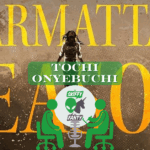Could chocolate somehow bring about the apocalypse? Does a group of middle-aged women hold the fate of humanity in their hands? These are some of the many questions tackled in Gillian Polack’s new science fiction novel, The Year of the Fruitcake: or Aliens with Irony. It’s a complex, fiercely feminist narrative that tackles issues of colonialism, cultural appropriation, and the marginalisation of women.
 An alien anthropologist is embedded as a middle-aged Australian woman in 2016 as part of an attempt to uncover the factors that led to an unspecified cataclysm. If this sounds a little vague, that’s because it’s difficult to summarise exactly what this story is about. The tale is divided into three headings: “The Observer’s Notes,” “Notes towards an Understanding of the Problem,” and “The woman’s slow voice was counting again.” Each of these is told in first person, though “Notes towards an Understanding of the Problem” often reads more like third person. As with most first person stories, the narrator is unreliable, and for much of the book, it remains unclear whether these sections are being told by the same character. Nor is the nature of the cataclysm made clear, with the series of events merely being referred to as fruitcake. An outline does develop as the story progresses, but much of it remains implicit. This obfuscation is unusual in modern speculative fiction, but remains crucial to the themes of the book.
An alien anthropologist is embedded as a middle-aged Australian woman in 2016 as part of an attempt to uncover the factors that led to an unspecified cataclysm. If this sounds a little vague, that’s because it’s difficult to summarise exactly what this story is about. The tale is divided into three headings: “The Observer’s Notes,” “Notes towards an Understanding of the Problem,” and “The woman’s slow voice was counting again.” Each of these is told in first person, though “Notes towards an Understanding of the Problem” often reads more like third person. As with most first person stories, the narrator is unreliable, and for much of the book, it remains unclear whether these sections are being told by the same character. Nor is the nature of the cataclysm made clear, with the series of events merely being referred to as fruitcake. An outline does develop as the story progresses, but much of it remains implicit. This obfuscation is unusual in modern speculative fiction, but remains crucial to the themes of the book.
The choice of structure isn’t merely to create some kind of tension around what happened. It’s also something that arises from the very nature of the narrator. Humans, we are frequently reminded, are creatures of story. Narratives permeate our cultures and are how we make sense of the world. This is not the case for the aliens of the story, who instead turn to mathematics. The kind of story-telling that humans engage in is foreign to them. Naturally, a story told by one of these aliens — even one embedded as a human — is not going to look how we might expect and may be perceived as less skilled. For example, the style is recursive, particularly in the beginning. Phrases are repeated in close succession. The narrator is easily side-tracked. Events are told seemingly at random. But these at times frustrating quirks improve along the way, and the events become more linear and easier for the reader to follow. This mirrors the narrator’s increasing connection to humanity in stylistic choices that are subtle and clever.
While the aliens make sense of the world in ways that are different to our own, there remains in common the concept of scientific objectivity. The anthropologist must be embedded in a human culture in order to get a deep sense of what is important to us and how we think, but should ultimately remain objective. Indeed, this is supported by some of the language used and the way the narrative is categorised as field notes or notes for an official report. However, the alien anthropologist explicitly laughs at the ridiculousness of such an idea. After all, how can one be embedded in a culture, make friends, and fully participate in its life while still managing to remain separate? Not only that, but even those systems purporting to be objective have their biases.
Any alien anthropologist embedded with humanity is seen as tainted and so any recommendation they make regarding the worth of humanity may be suspect; the alien authorities will continue to judge us by their own ideas of how similar we are to them. This bias is supported by corruption among the lower levels of the system as the technicians who maintain the human bodies and the alien memories of the anthropologists use their position to steal and commodify objects and human experiences of emotional importance to the anthropologists. Thus the story looks at cultural appropriation in a very concrete and visceral way, illustrating the humiliation and helplessness experienced by those being taken from. For example, the technicians take the anthropologist’s wedding ring to sell on the black market, leaving her to explain its disappearance to her husband.
The antidote to this humiliation and helplessness lies in the alien’s human friends — a group of four other women who met by chance and form close bonds. All are middle-aged, like the protagonist, but remain very different from each other. Trina is a lesbian activist who swears like a sailor. Leanne is a somewhat conservative scientist with spiritual beliefs. Janet is a writer with three kids and a walking stick. Diana suffers from chronic illness. And Antoinette is a transgender Aboriginal woman. The way these five support each other is a balm to the heart. They are all aware that the world is not always kind to the middle-aged, women, and/or marginalised. So, despite their differences, they always remain respectful and develop systems for indicating when there are things, big and small, going on that they want to talk about or avoid. They battle hurt with small joys, like chocolate, flowers and picnics, and come together to help out in medical emergencies or plain rotten days. Everyone needs friends like these. Nor do they come across as idealised, but have times when they are grumpy and not at their best. In them, I could recognise fragments of women I know.
There is so much more I could say about this book, since it covers so much — issues of memory, gender and chronic illness I haven’t even touched on. Readers who love books with depth and a more experimental literary style should definitely check out The Year of the Fruitcake.
The Year of the Fruitcake was released in July 2019 by IFWG Publishing Australia. It is available where all good books are sold.







